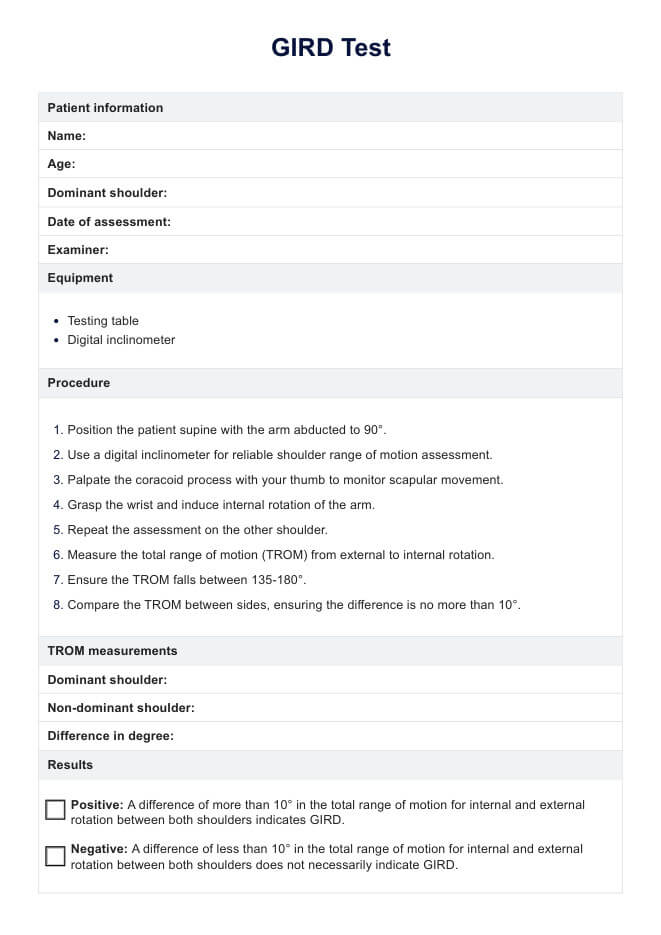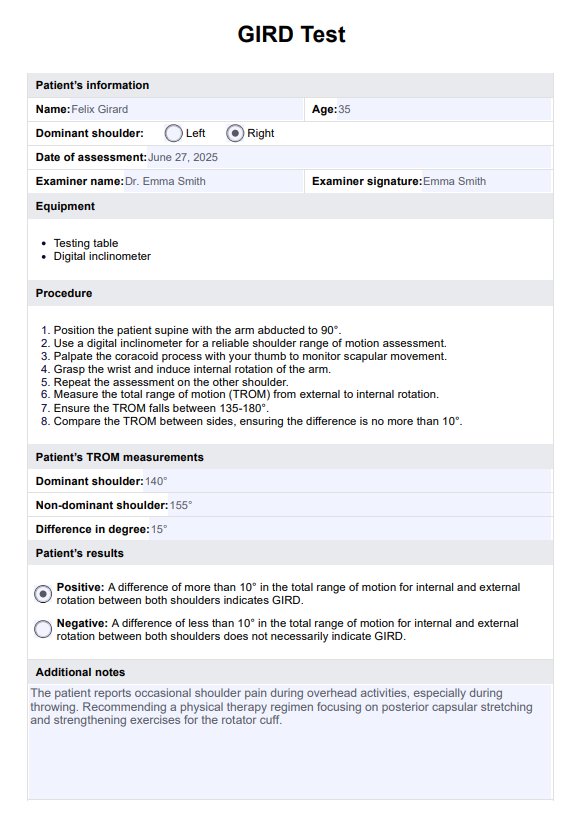GIRD Test
Looking for a GIRD test example? Download Carepatron's free PDF with sample questions and answers to practice for the GIRD test.


What is glenohumeral internal rotation deficit (GIRD)?
Glenohumeral internal rotation deficit (GIRD) is a condition commonly observed in athletes, particularly in sports involving repetitive overhead motions like throwing. It refers to a measurable loss of internal rotation range of motion (ROM) in the dominant shoulder compared to the contralateral shoulder. This deficit often results from adaptive changes in the throwing shoulder joint due to the demands of repetitive motions, such as in baseball pitchers.
The primary contributors to GIRD include posterior capsular tightness and adaptive changes in the posterior shoulder structures, including the posterior capsule and posterosuperior rotator cuff. These changes can lead to decreased internal rotation and increased external rotation in the superior shoulder, which may predispose athletes to shoulder injuries, including rotator cuff tears.
Management of GIRD typically involves a combination of physical therapy techniques aimed at restoring shoulder ROM and addressing posterior capsular tightness. These may include specific exercises for stretching the posterior capsule, strengthening the rotator cuff muscles, and modifying throwing mechanics to reduce stress on the shoulder joint.
Understanding and addressing GIRD is crucial in preventing shoulder injuries and maintaining optimal shoulder function in athletes and individuals engaged in repetitive overhead activities. Regular assessment of shoulder range of motion and addressing deficits early can help in managing and preventing complications associated with GIRD.
GIRD Test Template
GIRD Test Sample
What is the GIRD Test?
The GIRD Test, short for Glenohumeral Internal Rotation Deficit Test, is a clinical assessment used to quantify the degree of internal rotation deficit in the shoulder joint. It specifically measures the difference in internal rotation between the dominant and non-dominant shoulders, commonly seen in athletes, particularly baseball pitchers, due to the repetitive stress of throwing motions.
Identifying GIRD through this test is crucial as it helps in early detection and intervention to prevent potential shoulder injuries such as rotator cuff tears or labral tears. Treatment may involve specific stretching exercises targeting the posterior capsule and rotator cuff, along with modifications in throwing mechanics for athletes to alleviate stress on the shoulder joint.
The GIRD Test plays a vital role in the assessment and management of shoulder conditions, particularly in athletes involved in overhead sports like baseball, where shoulder health is critical for performance and longevity in the sport.
How to perform the GIRD Test
Performing the GIRD Test involves a systematic approach to accurately measure and assess internal rotation deficit in the shoulder. Follow these steps to conduct the GIRD Test effectively:
Step 1: Preparation and positioning
Have the patient lie comfortably on their back on an examination table. Abduct the shoulder to 90 degrees and flex the elbow to 90 degrees. Ensure the shoulder is in a neutral rotation position. Stabilize the scapula to isolate movement to the glenohumeral joint.
Step 2. Measurement of internal rotation
With the forearm initially positioned perpendicular to the table, measure the angle of internal rotation using a goniometer. Measure the maximum internal rotation of the controlling shoulder by rotating the forearm towards the table. Repeat the measurement for the non-controlling shoulder for comparison.
Step 3. Recording measurements
Record the degrees of internal rotation for both shoulders. Calculate the difference in internal rotation between the dominant and non-dominant shoulders to identify any GIRD.
Step 4. Using the Carepatron template
Utilize the GIRD Test template provided by Carepatron for standardized documentation. Enter the measured values and findings into the template for easy reference and comparison over time. Use the template to track changes in internal rotation deficit and effectiveness of interventions, such as posterior capsular stretching or strengthening exercises.
Results and interpretations of the GIRD Test
Interpreting the results of the GIRD Test involves understanding the measured differences in internal rotation between the dominant and non-dominant shoulders.
A positive result means the total range of motion for internal and external rotation between both shoulders is more than 10 degrees, indicating GIRD. This is typically observed in athletes with repetitive overhead activities like throwing. This deficit manifests as reduced internal rotation in the controlling shoulder compared to the non-dominant side, often due to posterior capsular tightness or adaptive changes in the shoulder joint.
Conversely, a negative result suggests minimal or no difference in external and internal rotation between shoulders, indicating balanced shoulder mobility.
Benefits of using our template
Using the Carepatron GIRD Test template offers several advantages for healthcare practitioners and athletes involved in overhead sports like baseball pitchers:
Standardized assessment
Ensure consistency in assessing Glenohumeral Internal Rotation Deficit (GIRD) across different patients and over time. Facilitate accurate comparison of internal rotation measurements between the dominant and non-dominant shoulders.
Comprehensive documentation
Record detailed measurements of internal rotation deficits, facilitating precise tracking of shoulder mobility changes. Document findings related to posterior capsular tightness or structural adaptations crucial for tailored treatment plans.
Enhanced communication
Improve communication between healthcare providers and athletes regarding shoulder health and potential risks associated with repetitive throwing. Aid in educating athletes about the importance of shoulder maintenance and injury prevention strategies.
Promotes early intervention
Early detection of GIRD enables timely interventions to prevent shoulder problems like rotator cuff tears or internal impingement. Optimize shoulder function and performance in professional baseball pitchers and other overhead athletes through targeted management strategies.
Commonly asked questions
To test for glenohumeral internal rotation deficit (GIRD), use a goniometer to measure internal rotation in both shoulders and compare the range of motion between the dominant and non-dominant sides.
"GIRD" stands for Glenohumeral Internal Rotation Deficit, a condition characterized by reduced internal rotation range of motion in the dominant shoulder compared to the non-controlling shoulder.
The normal range for GIRD is typically considered to be less than 18-20 degrees of difference in internal rotation between the dominant and non-dominant shoulders.
Shoulder GIRD itself is not painful, but it may contribute to discomfort or pain due to associated conditions like posterior capsular tightness or overuse injuries common in overhead athletes. Early detection and management can help prevent pain and injury progression.







































































































